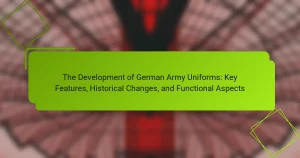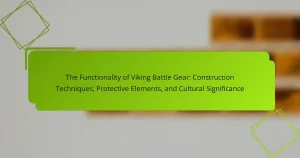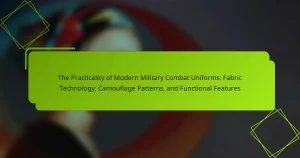Roman Legionary Armor refers to the protective gear utilized by soldiers in the Roman legions, primarily featuring the lorica segmentata, a segmented iron armor that ensured both protection and mobility. This armor was complemented by the galea helmet, often adorned with a crest, and the scutum, a large rectangular shield for defense. The article explores various armor types, including the lorica hamata, a chainmail variant, and the lorica squamata, characterized by scale patterns. It also highlights the historical significance of these armors in military evolution and their lessons for modern protective gear design, emphasizing the importance of layered protection, flexibility, and durability in contemporary applications.

What is Roman Legionary Armor?
Roman Legionary Armor is the protective gear worn by soldiers in the Roman legions. This armor typically included a lorica segmentata, which is made of iron strips. The armor provided essential protection during battles. It was designed to cover the torso while allowing for mobility. Legionaries also wore a helmet called a galea. The galea often featured a crest for identification. Additionally, soldiers used a scutum, a large rectangular shield, for defense. Roman armor evolved over time, reflecting advancements in military tactics and technology.
How did Roman Legionary Armor evolve over time?
Roman Legionary Armor evolved significantly from the early Republic to the late Empire. Initially, armor consisted of simple bronze or iron breastplates. By the 1st century BCE, the gladius and scutum became standard, enhancing protection and combat effectiveness. The lorica hamata, a chainmail armor, emerged in the 2nd century BCE, offering flexibility and better defense.
In the 1st century CE, the lorica segmentata, made of metal strips, provided superior protection and was easier to manufacture. This armor type became iconic for Roman soldiers. Over time, decorative elements were added, reflecting rank and unit. By the late Empire, armor began to include more complex designs and materials, adapting to changing warfare needs.
These changes were influenced by various factors, including technological advancements and encounters with other cultures. The evolution of Roman Legionary Armor reflects the military’s adaptability and the empire’s expansion.
What are the key materials used in the construction of Roman Legionary Armor?
The key materials used in the construction of Roman Legionary Armor include iron, bronze, and leather. Iron was primarily used for the lorica segmentata, the segmented armor that provided flexibility and protection. Bronze was often utilized for decorative elements and fittings, adding both beauty and functionality. Leather was used for straps and components that required flexibility and comfort. These materials were chosen for their durability and effectiveness in battle. Historical evidence indicates that the combination of these materials contributed significantly to the effectiveness of Roman soldiers in combat.
What design features distinguish Roman Legionary Armor from other types of armor?
Roman Legionary Armor is distinguished by its specific design features, including the lorica segmentata, a segmented metal armor. This armor consists of strips of iron that provide flexibility and protection. The use of a large rectangular shield, known as the scutum, further sets it apart. The scutum is designed for both defense and offense in formations. Roman armor also typically includes a helmet with a distinctive crest, enhancing visibility and intimidation. The overall design emphasizes mobility, allowing soldiers to maneuver effectively in battle. These features collectively contributed to the effectiveness of Roman legions in warfare.
What functional aspects does Roman Legionary Armor provide?
Roman Legionary Armor provides protection, mobility, and psychological advantages in battle. The armor, primarily composed of metal plates, shields the wearer from slashing and piercing attacks. It includes a helmet that protects the head and face. The segmented design allows for greater flexibility and movement. Legionaries could engage in combat without being overly restricted. The armor also featured a distinctive appearance, instilling fear in opponents. Historical records indicate that Roman soldiers were more effective in battle due to their armor. The use of armor contributed to the Roman military’s success and longevity.
How does Roman Legionary Armor enhance soldier protection in battle?
Roman Legionary Armor enhances soldier protection in battle through its robust design and materials. The armor typically consists of a metal breastplate, known as a lorica segmentata, which provides vital coverage to the torso. This segmented design allows for flexibility while ensuring strong defense against slashing and stabbing attacks. The armor also includes shoulder guards and a helmet, which protect critical areas of the head and neck.
The use of iron and bronze in construction increases durability, making it effective against weapons of the time. Historical evidence shows that Roman soldiers wearing this armor had a significantly higher survival rate in combat. Additionally, the armor’s weight is balanced to allow for mobility, enabling soldiers to maneuver effectively while still being protected. The comprehensive coverage and material strength of Roman Legionary Armor make it a key factor in enhancing soldier safety during battles.
What role does mobility play in the effectiveness of Roman Legionary Armor?
Mobility is crucial for the effectiveness of Roman Legionary Armor. The armor’s design balances protection and movement. Legionaries needed to maneuver swiftly in battle. Heavy armor could hinder movement, reducing combat effectiveness. The segmented design of lorica segmentata allowed flexibility. This design enabled soldiers to move arms and legs freely. Historical accounts show that mobility contributed to tactical advantages. Quick repositioning and flanking maneuvers were essential in Roman warfare. Thus, mobility directly influenced the success of legionary formations.
Why is the historical significance of Roman Legionary Armor important?
The historical significance of Roman Legionary Armor is important because it reflects the military innovations of ancient Rome. This armor was crucial for the effectiveness and success of the Roman legions. It provided protection, allowing soldiers to engage in combat with reduced risk of injury. The design and materials used in the armor demonstrated advanced metallurgy and craftsmanship for the time. Additionally, the armor symbolized the power and discipline of the Roman military. Its evolution over time showcases changes in tactics and warfare. The legacy of Roman Legionary Armor influences modern military gear and design. Historical artifacts of this armor provide insights into Roman society and its values.
How did Roman Legionary Armor influence military tactics in ancient Rome?
Roman Legionary Armor significantly influenced military tactics in ancient Rome by enhancing the effectiveness of soldiers in battle. The armor’s design provided superior protection, allowing legionaries to engage in close combat with reduced risk of injury. This protection encouraged more aggressive tactics, as soldiers could advance confidently against enemy lines. The use of the shield, in particular, facilitated the formation of the testudo, or tortoise formation. This formation allowed soldiers to protect themselves while advancing towards enemy fortifications.
Additionally, the armor’s weight and structure influenced the speed and maneuverability of troops. Heavily armored soldiers were often deployed in the front lines, while lighter troops supported them from the flanks. This tactical flexibility enabled the Roman army to adapt to various combat scenarios effectively. The combination of protection and mobility provided by the armor allowed for coordinated attacks and strategic retreats. Historical records indicate that these tactics contributed to Rome’s military dominance during its expansion.
What can we learn about Roman society through the study of Legionary Armor?
The study of Legionary Armor reveals key aspects of Roman society. It illustrates the military organization and discipline of the Roman legions. The armor’s design reflects the technological advancements of the time. Specific materials used indicate trade relationships and resource availability. The evolution of armor types shows changes in warfare tactics and strategies. Additionally, armor styles can indicate social status within the military ranks. The craftsmanship involved highlights the skills and economic conditions of Roman artisans. Overall, Legionary Armor serves as a tangible link to understanding Roman cultural values and societal structure.

What are the variants of Roman Legionary Armor?
The variants of Roman Legionary Armor include the Lorica Segmentata, Lorica Hamata, and Lorica Squamata. The Lorica Segmentata is characterized by its segmented plates, providing flexibility and protection. It was widely used during the late Republican and early Imperial periods. The Lorica Hamata consists of chainmail, offering good protection against slashing attacks. This armor was common in earlier periods and remained in use for its effectiveness. The Lorica Squamata features scales sewn onto a fabric backing, providing a unique appearance and decent defense. Each variant reflects the evolving needs of Roman soldiers in different combat scenarios. Historical evidence shows that these armors were adapted based on advancements in warfare and materials available.
How do different types of Roman Legionary Armor compare?
Different types of Roman Legionary armor vary in design, materials, and protection levels. The most common types include the lorica segmentata, lorica hamata, and lorica squamata. Lorica segmentata features metal strips that provide excellent protection and flexibility. It was widely used during the late Roman Republic and early Empire. Lorica hamata is made of chainmail, offering good protection while allowing for greater mobility. This type was favored in earlier periods and by auxiliary troops. Lorica squamata consists of scale armor, providing solid defense with less weight than segmentata. Each type reflects varying tactical needs and technological advancements of the Roman military. Historical evidence shows that the choice of armor depended on the specific role of the soldier and the combat context.
What are the characteristics of the Lorica Segmentata?
The Lorica Segmentata is a type of Roman armor known for its segmented plates. It consists of metal strips that are fastened together, allowing flexibility and protection. This armor typically covers the torso and shoulders. It is designed to provide a balance between mobility and defense. The Lorica Segmentata is often made from iron or bronze. Its construction allows for ease of movement during combat. Historical evidence indicates it was widely used by Roman soldiers from the 1st century AD. The armor is characterized by its distinctive overlapping plates, which enhance its protective capabilities.
How does the Chainmail variant differ from other types of armor?
Chainmail differs from other types of armor in its construction and flexibility. Chainmail consists of interlinked metal rings, providing a unique combination of protection and mobility. This design allows for greater movement compared to solid plate armor, which can be restrictive. Unlike leather armor, chainmail offers superior defense against slashing attacks due to its ring structure. Historical evidence shows that chainmail was widely used by various cultures, including Roman soldiers, for its effectiveness in combat. The adaptability of chainmail made it suitable for different fighting styles, enhancing its appeal over other armor types.
What factors contributed to the diversity of Roman Legionary Armor?
The diversity of Roman Legionary Armor resulted from various factors. These include geographical differences, evolving combat techniques, and cultural influences. Regions conquered by Rome had distinct materials and designs. Local craftsmanship contributed to variations in armor styles. Changes in military tactics also necessitated different armor types. The introduction of new technologies, such as improved metalworking, influenced armor construction. Additionally, the integration of auxiliary forces brought diverse influences into Roman military gear. Historical records show that these factors led to significant variation in armor across different periods and locations within the Roman Empire.
How did regional differences impact the design of Roman Legionary Armor?
Regional differences significantly influenced the design of Roman Legionary Armor. Various regions produced armor that reflected local materials and combat styles. For example, in Gaul, the use of chainmail became more prevalent due to the availability of iron. This contrasted with armor from Italy, which often featured more plate elements. Additionally, the climate of a region dictated armor weight and ventilation. In hotter areas, lighter armor was favored for mobility. Conversely, colder regions saw heavier armor to provide better protection. Historical evidence shows that the adaptation of armor was crucial for effectiveness in diverse battle environments. This regional customization allowed Roman legions to maintain their dominance across varied terrains.
What role did advancements in technology play in armor variations?
Advancements in technology significantly influenced armor variations throughout history. Innovations in metallurgy allowed for stronger and lighter materials. This led to the development of more effective protective gear. The introduction of new manufacturing techniques enabled intricate designs and improved fit. For example, the transition from bronze to iron and steel enhanced durability. Additionally, advancements in weaponry prompted changes in armor design to counteract new threats. Historical evidence shows that Roman armor evolved in response to these technological changes. The gladius and pilum influenced the shape and structure of legionary armor. These factors collectively demonstrate the critical role of technology in armor variations.

How can we apply the lessons from Roman Legionary Armor today?
The lessons from Roman Legionary Armor can be applied today in various fields, including design and materials science. The armor’s effective use of layered protection showcases the importance of combining materials for enhanced safety. Modern protective gear can benefit from this principle by utilizing composite materials that absorb and distribute impact.
Additionally, the armor’s mobility design highlights the need for flexibility in protective equipment. This can influence the development of tactical gear for military and law enforcement. The historical significance of Roman armor in adapting to battlefield conditions can inform contemporary approaches to personal protective equipment.
Lastly, the emphasis on durability in Roman armor serves as a reminder for manufacturers to prioritize long-lasting materials in modern designs. By studying these principles, industries can create more effective and resilient protective solutions.
What modern applications can we draw from the design of Roman Legionary Armor?
Modern applications of Roman Legionary Armor design include advancements in personal protective equipment. The layered construction provides insight into effective armor design for military and law enforcement use. The use of metal and leather in the armor informs materials science in creating lightweight, durable protective gear. The articulation in the armor allows for enhanced mobility, influencing modern tactical gear design. Additionally, the historical effectiveness of Roman armor against various weapons informs contemporary ballistic protection standards. Research shows that historical designs can inspire innovations in modern combat gear. Studies in biomechanics also suggest that the ergonomic aspects of Roman armor can enhance comfort in modern applications. Overall, the design principles of Roman Legionary Armor continue to influence contemporary protective equipment development.
How can historical insights improve contemporary military armor design?
Historical insights can enhance contemporary military armor design by providing tested principles of protection and mobility. For instance, Roman legionary armor, such as the lorica segmentata, was designed for optimal defense while allowing flexibility. This balance of protection and movement is crucial in modern combat scenarios.
Additionally, historical materials like bronze and iron inform current material science advancements. Research indicates that modern alloys can mimic the durability of these historical materials while reducing weight.
Furthermore, the layered approach of historical armor can inspire modern designs. Layered armor can effectively distribute impact forces, a principle that has been validated in both historical and contemporary contexts.
By analyzing historical failures and successes in armor design, contemporary engineers can avoid past mistakes. For example, the vulnerabilities of chainmail against certain weapons led to innovations in plate armor.
In summary, historical insights from Roman legionary armor can guide contemporary military armor design through lessons in balance, materials, layering, and learning from past experiences.
What best practices can be learned from the use of Roman Legionary Armor?
Roman Legionary Armor exemplifies best practices in military design and functionality. Its layered construction provided both flexibility and protection. The use of metal plates allowed for durability against various combat situations. The incorporation of leather straps ensured a secure fit and ease of movement. Standardization of armor facilitated mass production and uniformity among soldiers. This approach enhanced logistical efficiency in supplying troops. The attention to ergonomic design improved soldier endurance during prolonged engagements. Historical evidence shows that effective armor contributed to the Roman military’s dominance in battle.
Roman Legionary Armor is the protective gear worn by soldiers in the Roman legions, designed to provide essential protection while allowing mobility in battle. This article explores the evolution of Roman armor, detailing key materials such as iron, bronze, and leather, as well as distinct design features like the lorica segmentata and scutum. It examines the functional aspects of the armor, its historical significance in military tactics, and the different variants, including lorica hamata and lorica squamata. Additionally, the article highlights how insights from Roman armor design can inform modern military applications and best practices in protective gear development.




